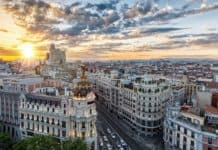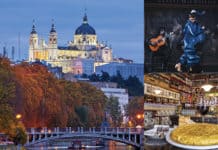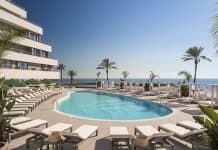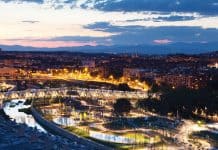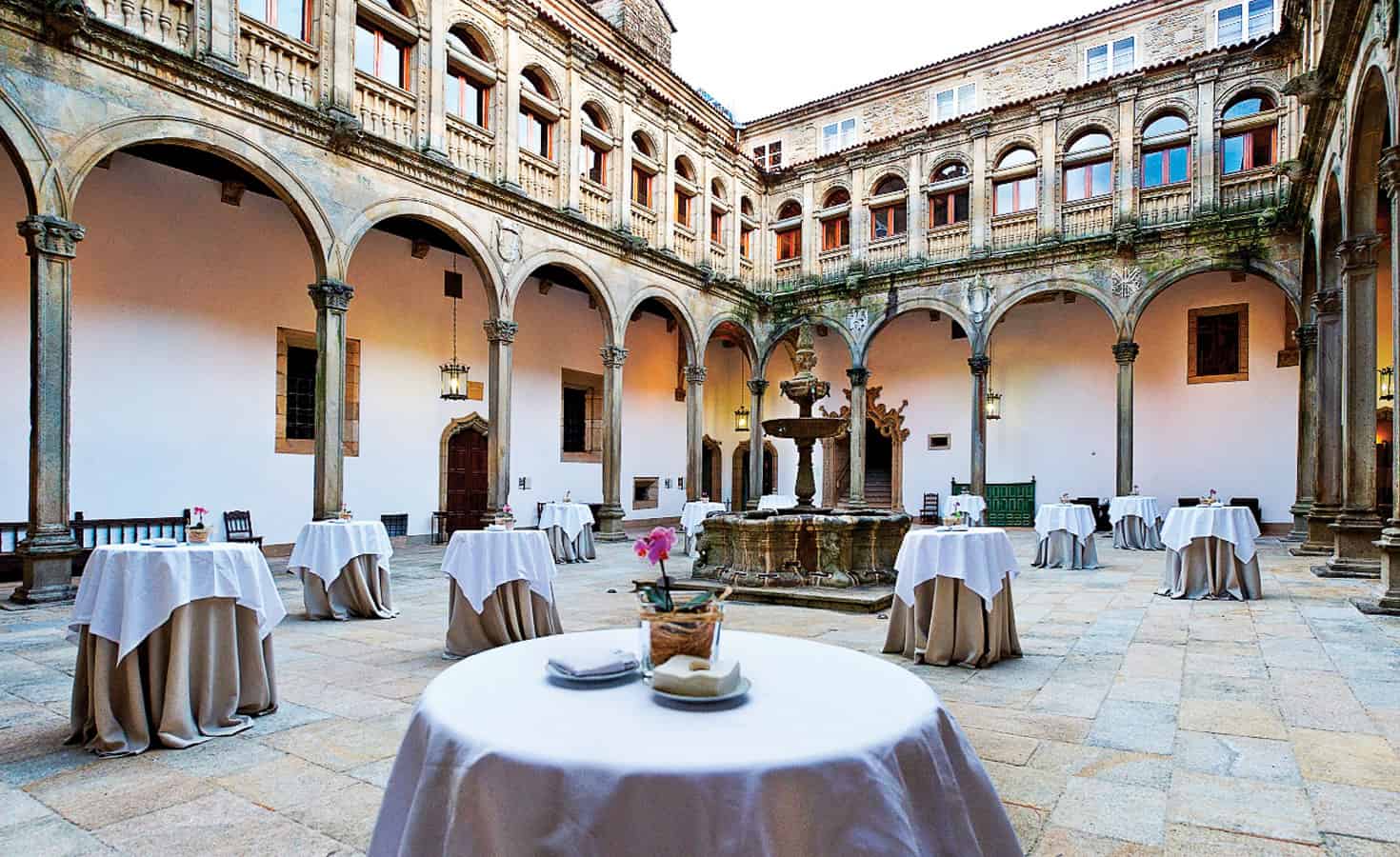 Painted yellow arrows veer within Spain’s hilly highlands and coastal plains, but all point to The Way.
Painted yellow arrows veer within Spain’s hilly highlands and coastal plains, but all point to The Way.
The eight main pilgrimage routes of Camino de Santiago cut across the country like arteries, pumping seekers into the UNESCO World Heritage city of Santiago de Compostela and its cathedral where the remains of St. James the apostle are purportedly held. The Camino has been traversed by Christians and those of other faiths for more than a millennium. Today’s nearly 280,000 annual trekkers, including a growing number of US corporate and incentive groups, walk the storied road for reasons that are as varied as Spain’s history and landscapes. That doesn’t matter, says Juan Pensado Barbeira, Tourism Galicia’s group director for Camino de Santiago. Whether attempting a deeper connection with the divine, escape from the daily grind or to experience the first European Cultural Route, most begin “the walk as tourists and end as pilgrims.”
“More and more people realize that The Way is a meeting place; a space where ideas, different beliefs, cultures and even religions are shared with other people,” Pensado Barbeira explains. “We live in such a hurry. Always running in search of success and money; always busy and without time for relationships. Sharing something as simple as a walking trip, with only the essentials, allows people to disconnect from the world and just be themselves.”
Our six-day trek across Galicia, in northwestern Spain, revealed more than a few interpretations of The Way.
The French Way
Even on the quietest stretch of road where only the chirping of crickets, clickety-clack of walking poles and the occasional buen Camino, or “good Way” greeting, can be heard for miles, a complete disconnect from the world is hard to find. Our guide, Diego Lamas, says this is actually a good thing. “The Camino was made by breaking bread and drinking wine with locals and peregrinos (pilgrims),” after all. “You can be pilgrims and have very good gastronomy at wonderful prices—you don’t have to be hard on yourselves.” We walk a few miles of the Camino here along a country dirt road with vast green fields, sporadic wildflower color pops, curious horses and a sweet smelling eucalyptus forest. “It’s not a competition,” Lamas says, as our group splinters off into subgroups and individuals to accommodate different walking paces. “You walk and your mind stops chatting; you lose notion of time—kind of like yoga.” Groups that are bold enough to walk the entire French Way, which is the most walked of all routes, will cross nine wine regions, each with their own culinary specialties. Entire villages often make their living by renting out rooms within their homes and selling homemade cheeses, wines and other delectables to the pilgrims who pass. Many restaurants also put a modern spin on this tradition of sharing by offering free WiFi and affordable three-course pilgrim’s menus.
We live in such a hurry. Always running in search of success and money; always busy and without time for relationships. Sharing something as simple as a walking trip, with only the essentials, allows people to disconnect from the world and just be themselves.
We stopped by O Mirador, overlooking the Mino River in the village of Portomarin. The restaurant not only offers free WiFi, but daily menus reflecting the best of Galician gastronomy, including a special “brew” of coffee beans, lemon and orange skins, orujo (a transparent spirit distilled from wine), sugar and honey to drive away the witches. Groups that require a little magic can listen to the Queimada spell’s incantation and stare into hypnotizing spikes of blue flames as the concoction is lit on fire. Of course, they’ll also need to take a sip, and that is the real test.
Witches aside, nearby Sarria is the most popular starting point of The Way. The distance from the medieval village to Santiago de Compostela is the minimum that pilgrims need to obtain Compostela, or the official certificate given by the Church (written entirely in Latin) that proves they have walked 100km (62 miles) of the Camino. Here, groups will find many cultural treasures, and a fair also takes place three times a month to highlight traditional products of the area.
South of Sarria, O’Cebreiro, where the French Way and Galician Way intersect before reaching Santiago de Compostela, is known for the Church of Santa Maria and the golden chalice that held a miracle in the 12th century—the transformation of wine into Christ’s blood. Lesser known, is the inspiration it gave to German composer Richard Wagner’s “Parsifal” opera. The pre-Romanesque church is one of the oldest on the Camino; it’s regularly visited by pilgrims, who also pause to take in the vast views of O’Cebreiro valley and interesting cultural artifacts, such as the Ethnographic Museum and its carefully preserved palloza, or Celtic dwelling, which groups can tour. The energy here is contagious, as pilgrims flit from place to place to capture new stamps on their pilgrim’s passports that verify their walks. The scallop shell was originally used as proof of the pilgrimage, we’re told, the lines representing the routes leading into Santiago. Other more mystical legends of the scallop’s significance involving St. James also exist. Regardless, this is a great spot for groups to buy and don a shell (some say you’re not a true pilgrim without one). We join in on the action and receive a couple of stamps for keepsakes as well. This quickly becomes the norm everywhere we go and adds to the authenticity and excitement of the experience.
The last not to be missed stops on the French Way are the Vilar de Donas church and UNESCO World Heritage Pambre Castle in Palas de Rei. The massive red Romanesque doors of the church are like a shot of carajillo (coffee with liquor) against the lazy countryside, guarding important gothic frescos and tombs. The church’s history with the Order of the Knights of Santiago and the Templars, who were also defenders of the road, takes author Dan Brown’s “Da Vinci Code” to a whole new level. The castle has its own claim to fame as one of the best preserved medieval fortresses in Galicia, but it’s often its locally produced Arzua-Ulloa and tetilla cheeses that groups long remember.
The Portuguese Way
The last leg of the Portuguese route guides pilgrims through Spain’s coastal region, where the seaside resort town of Baiona, mixes medieval history with a five-star hotel and breezy, Cape Cod-like vibe. Columbus’ La Pinta ship docked here in 1493 carrying plant and animal species unknown to this area of the world, making Baiona the first port in Europe to receive the news of the “discovery” of America. Groups can tour a scaled replica of the boat and museum that is moored just offshore. The 12th century Monterreal Castle (mentioned as far back as Julius Caesars’ time), overlooking the Cies Islands, now houses the 122-room Parador de Baiona luxury hotel. Groups of more than 500 can meet here and experience sailing excursions with the Baiona Royal Yacht Club, hang-gliding, hiking, cycling, and, of course, the region’s famous Albarino wine and shellfish. We sampled classical regional dishes (many of which can be customized to various dietary needs, as this vegetarian noted) while overlooking the hotel gardens.
Vigo, Galicia’s economic powerhouse, is another coastal city along the Portuguese Way that will offer your pilgrims a unique experience. Aside from its array of beaches that are edged by winding walking trails, Vigo’s old quarter is somewhat of a hidden treasure. Full of museums, heritage monuments and statues and tucked away cafes, there’s something new to discover around every corner. Be sure to also check out Parque Monte del Castro for the best views in the city.
Cape Finisterre Way
Before holding the footsteps of pilgrims, this pre-Christian route held the secrets of the pagans as the perceived end of the known world. The stone “0,00 K.M.” marker in front of the Virxe da Barca church testifies to this heritage and is also a spot that generates more than a few selfies.
En route to the Cape, we pass through Ponte Maceira, a charming village lined with pazos (country mansions) and waterfalls and a medieval bridge that was built upon Roman foundations. A Romanesque chapel dedicated to Santa Maria das Areas, holds a much-worshipped figure of Christ whose hair and nails have been growing since the statue washed ashore, according to locals. Equally magical are the fertility-bestowing San Guillerme chapel ruins.
Reaching Cape Finisterre, many pilgrims embrace the age-old tradition of hiking down the side of the cliff, where the roar of the Atlantic pounds against the rocky peninsula and distant lighthouse, to burn their clothes at a seaside altar. It’s a beautiful metaphor that signifies the letting go of everything that does not serve the next chapter of one’s life, as discovered on this “journey into self,” as Pensado Barbeira, and nearly all of the pilgrims we interviewed along the Camino, call it. Acoustic musicians often hang out by the Cape and local lace makers greeted us with their delicate creations.
The last leg of the Cape Finisterre route before heading into Santiago de Compostela, feeling very much like pilgrims, as Pensado Barbeira suggested early on, began with dinner at the organic, Michelin-starred O Fragon restaurant. Here, tucked away behind the mountains in an ultra-modern building with floor-to-ceiling windows facing the sea, the chefs offer local fish specialties with eclectic twists, and, the piece de resistance for many at our table, razor clams. One week every year is also dedicated to the local razor clam festival. Leaving Cape Finisterre, we stop by Monte do Gozo, a.k.a. Hill of Joy, in Santiago de Compostela, where many a pilgrim have caught the first view of the city after a long and arduous journey—the three spires of Santiago de Compostela Cathedral—and wept with rapture.
The Road to Santiago
Bagpipes play in the Plaza del Obradoiro as we step out of the 15th century Parador de Santiago Compostela, a former pilgrim’s hospital that faces the famed cathedral, and into the morning air for a culinary tour of the city. But first, like most pilgrims, we venture down into the crypt of St. James and explore the gorgeous frescos of the church, before joining mass and watching the botafumaro swing over the standing-room-only crowd, offering hope, and to many, a fresh start. An extra bonus awaits groups on the roof, which is explorable with a guide and easy to traverse, despite its many twists and turns.
Galicia’s culinary scene runs the gamut of tastes, textures and flavors—from Michelin dining at Casa Marcelo to homemade almond cake served through a walk-up window by nuns at the Monastery of San Pelayo de Antealtares. A stroll through the mercado de abastos (food market) is a feast for the senses with strings of chorizos, mountains of seafood and cheese aromas at every turn. Colorful produce line the streets, but it’s the octopus—prepared on the street—that steals the show for most in our group. Aside from the almond cake, a Galician octopus dish epitomizes this area, we’re told.
Although corporate and incentive groups will find a mix of four- and five-star hotels (we also stayed at the UNESCO World heritage San Francisco Hotel Monumento), cottages and guest houses, many opt for hostels; the true pilgrim experience (some are downright upscale).
Tours can be customized according to the group’s needs, though Pensado Barbeira says the real awe-inspiring moment is generally derived from the road itself. “I believe that there is no more exclusive experience than to realize The Way of Santiago. This realization, both the physical and spiritual physical way, is an experience that only those who have made The Way know.”



